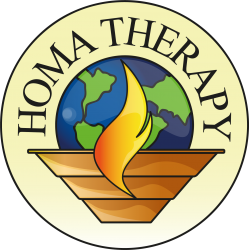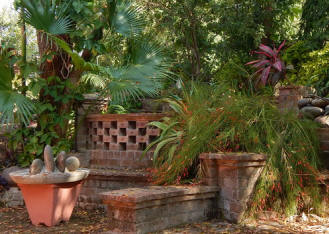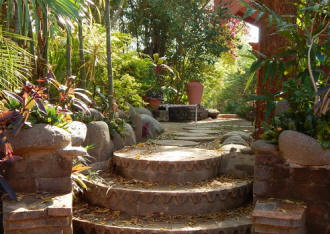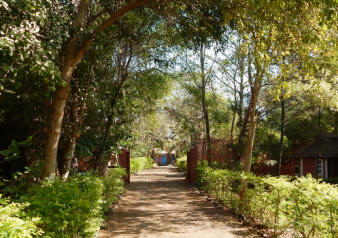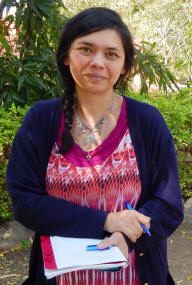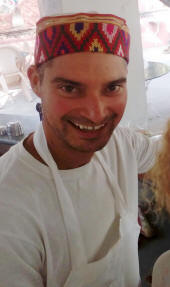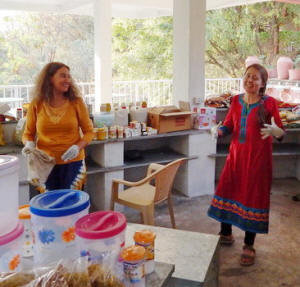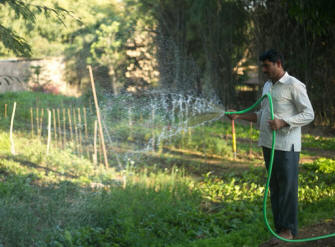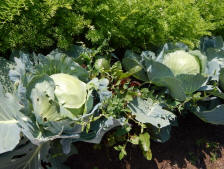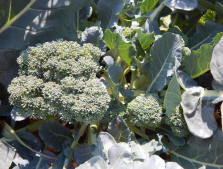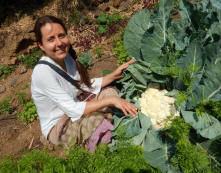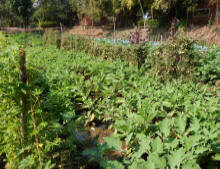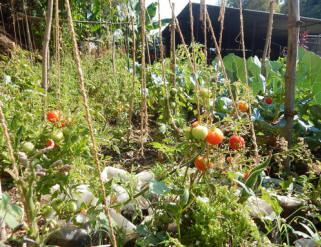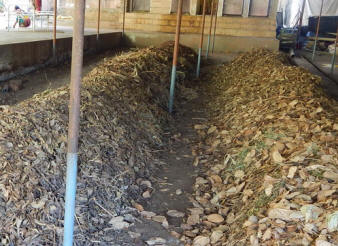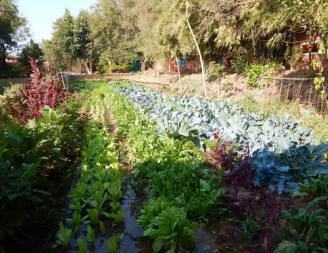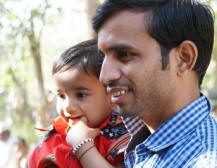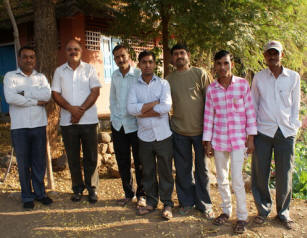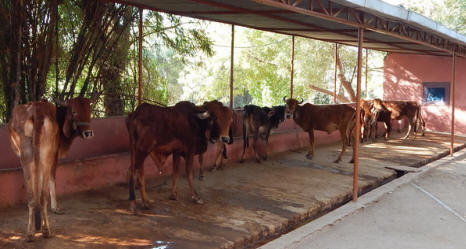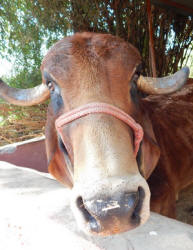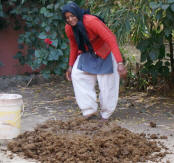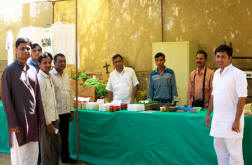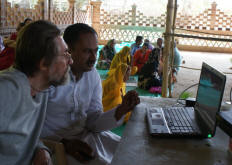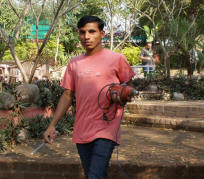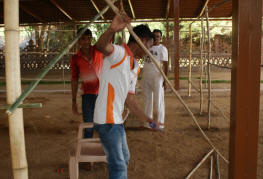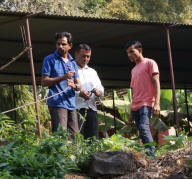|
||
|
Somayag 2017 – the Kitchen
|
|||
|
Kitchen duties & the wonderful spaces to enjoy the good Homa organic food. The responsibility for western cuisine was in the capable hands of Suwindi Kadir from Australia, Juan Rodrigues from Venezuela and Karina Ohme from Chile, while the Indian cuisine was in the hands of the experienced Maheshwar crew. Continue reading “Somayag 2017 – the Kitchen” |
Somayag 2017 – the Garden
|
|||
|
Photos: – Aaron Kidd and Bharat working in the Goshala garden, where everything grows healthy and abundant and in less time than usual. Aaron Kidd from Australia shares: "We planted a larger vegetable garden 3 months prior to the Somayag. |
|||
|
|||
|
Photo below: Karina Ohme from Chile harvesting a cauliflower for the kitchen. |
|||
|
|||
|
Aaron Kidd continued: |
|||
|
|||
|
|||
|
Photos on this page: Crops in Maheshwar Goshala and vermicompost beds. Below: Prashant with his son Sumit who, along with Bharat, is in charge of the Homa garden. |
|||
|
Somayag 2017 – Preparations
|
|||||
|
Dr. Ulrich Berk and Achal Apte preparing the Kundas for the Somayag; the "Tapovan and Maheshwar boys" as they are affectionately called. Under the guidance of Sanjay Patil, Anne Godfrey, Aaron Kidd, Prem Jogi and Sarvajit, they made Maheshwar shine. They renovated, painted, modeled, reconstructed, improved, renewed, washed, cleaned, … the buildings and land. They turned into electricians, plumbers, builders, painters, landscapers, farmers, etc. |
|||||
|
|||||
| With a smile they brought buckets of hot water for showers, heated in big pots on firewood, to the rooms long before dawn! Please receive everyone’s Gratitude, Love and Respect! |
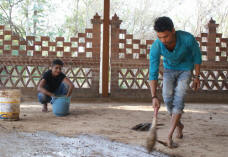 |
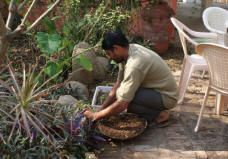 |
|||
|
|||||
|
|||||
Somayag Series Successfully Completed!
|
Bruce Johnson, Lisa Powers and the Somayag Committee |
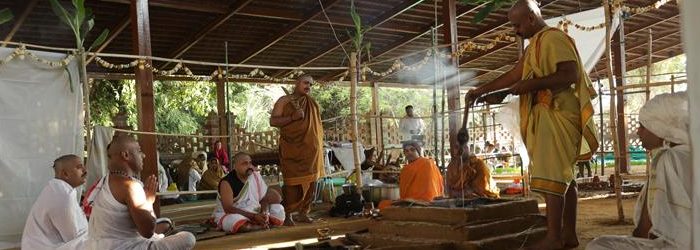 |
|
For the past ten years, a small group of dedicated people from various countries has held the vision of Shree Vasant Paranjpe of completing a series of seven Maha Somayags on the banks of the Narmada River in Maheshwar, Madhya Pradesh, India, for the healing of our planet. February 12th, 2017 marked the successful completion of the Aptoryam, the seventh and final Somayag in this series. Satsang applauds this achievement, and heartily thanks all who have helped to make this important work possible. The Somayag releases powerful healing energies into the Earth’s atmosphere and beyond, the effects of which last for up to 100 years. All these Yajnyas are totally non-violent (Ahimsak). Vedas are the source of all knowledge. Vedas gift us the science of Yajnya (bio-energy) which has the power to heal much of the horrific effects of man’s inhumanity towards his fellow man and towards Nature, which is now reeling from poisons, pollution, violence and violation of every kind. |
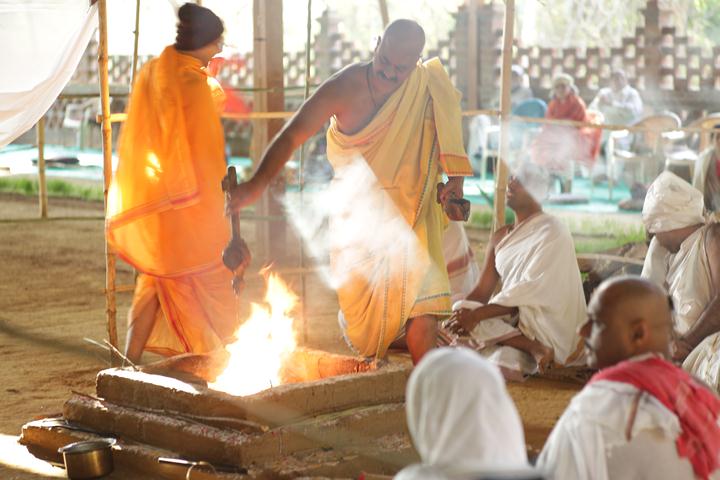 |
|
What is Somayag? AGNIHOTRA, tuned to the biorhythm of sunrise/sunset, is the basic YAJNYA which any person can perform with only a little effort. Agnihotra is to be performed DAILY at sunrise and sunset to keep the Nature’s cycles in harmony. |
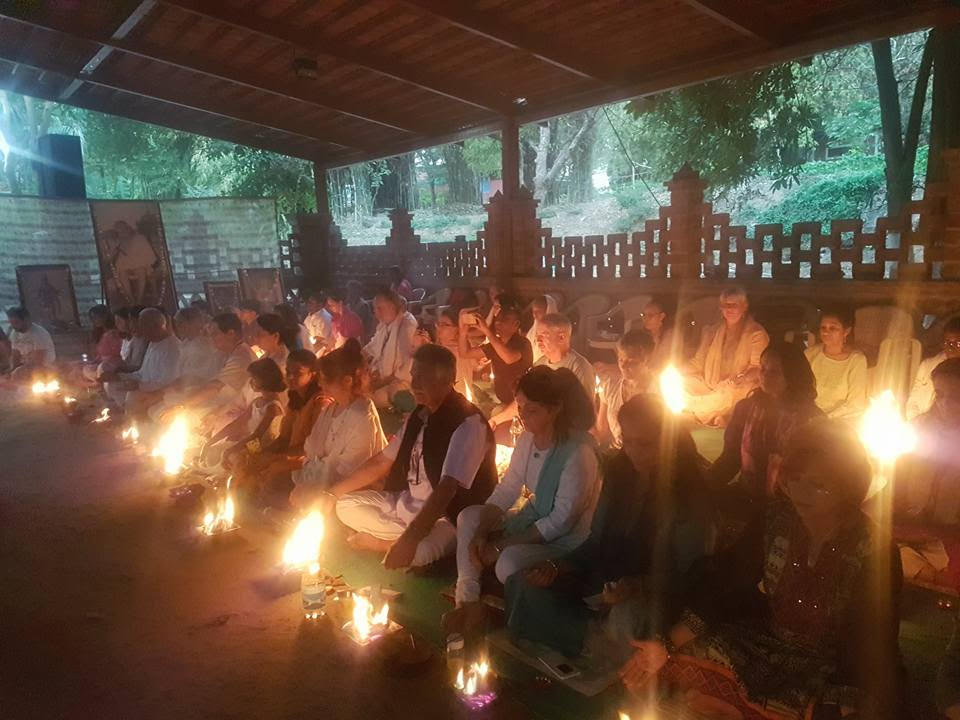 |
|
There are some special Yajnyas (HOMAS) like SOMAYAG, AGNISHTOMA, JYOTISHTOMA which are to be performed based on astronomic conditions. They are performed for purification of the environment, reducing the burden on the mind, making mind full of LOVE. In such Yajnyas chanting of Mantras and offerings to fire goes on for several days. At the junction of two seasons there is likelihood of epidemic. Hence, several medicinal HOMAS are prescribed with different sets of Mantras. Then there are special HOMAS for bringing rains, for producing a male child or a female child. This forms part of the science of Biogenetics. Somayag is one such special Yajnya. This normally lasts for six days. An intelligent young person would take about twelve years to learn this technique with proper Mantra chanting. The person has to follow strict disciplines. This Yajnya is called Somayag because juice from the herb Somavalli is used as the main oblation. Soma is known as the king of medicinal herbs. This special Yajnya provides an extra powerful boost of healing energy for the whole world. Countless positive benefits to a person, family and society are mentioned as an outcome of participating in, conducting and supporting Somayag. |
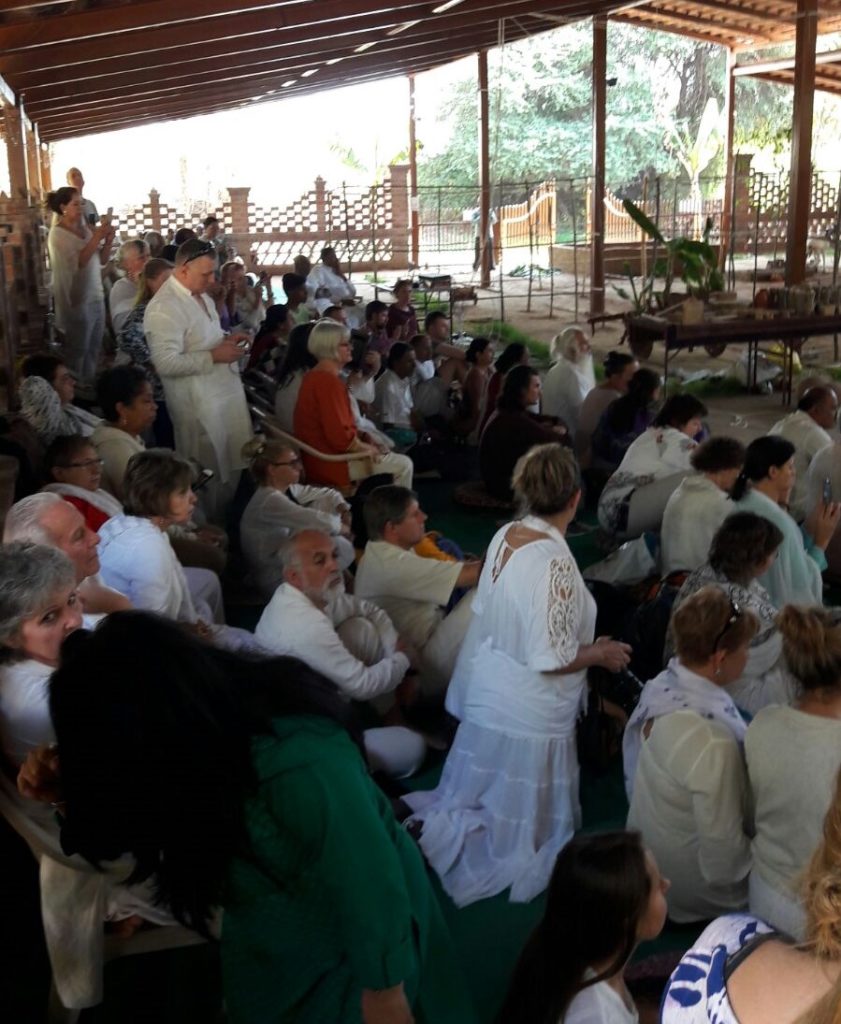 |
|
The primary seven Somayags are: There are many other Somayags, lasting from 6 days up to 12 years and more. The beneficial effect of each of these HOMAS lasts for several decades. The atmosphere becomes medicinal, nutritious and disease-free. Somayags yield a qualitative and quantitative improvement in the psyche. By using this supertechnology we can eradicate pollution factors on a large scale. The fumes emitted from the burning oblations in Yajnya serve as nucleus of clouds and rains. Smoke from the burning medicinal plants helps in the purification of the atmosphere and many disease-bearing germs are neutralized. Thus, a healthy ecosystem is created through Yajnya process. |
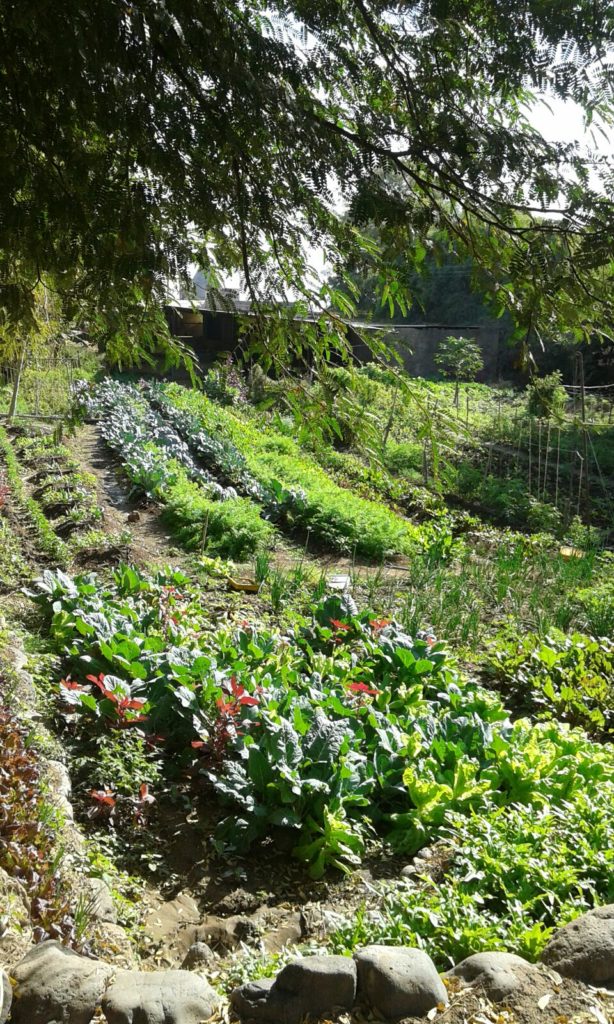 |
|
The Process of Somayag 2. Ishti fire. Ishti means whatever is inside us we offer to God. It is a basic requirement for the other steps of the Somayag. 3. Pravargya for three days. This is preparation for the Soma offering. 4. Soma offering. 5. Wrapping up–final offerings and prayers. 6. Bath in the Narmada River. The Yajaman The Yajaman represents the element of fire during a Somayag. Only someone who performs Tretagni Agnihotra regularly can become a Yajaman. He carries this Tretagni fire to the place where Somayag is to be performed and from this Tretagni fire the Somayag is started. |
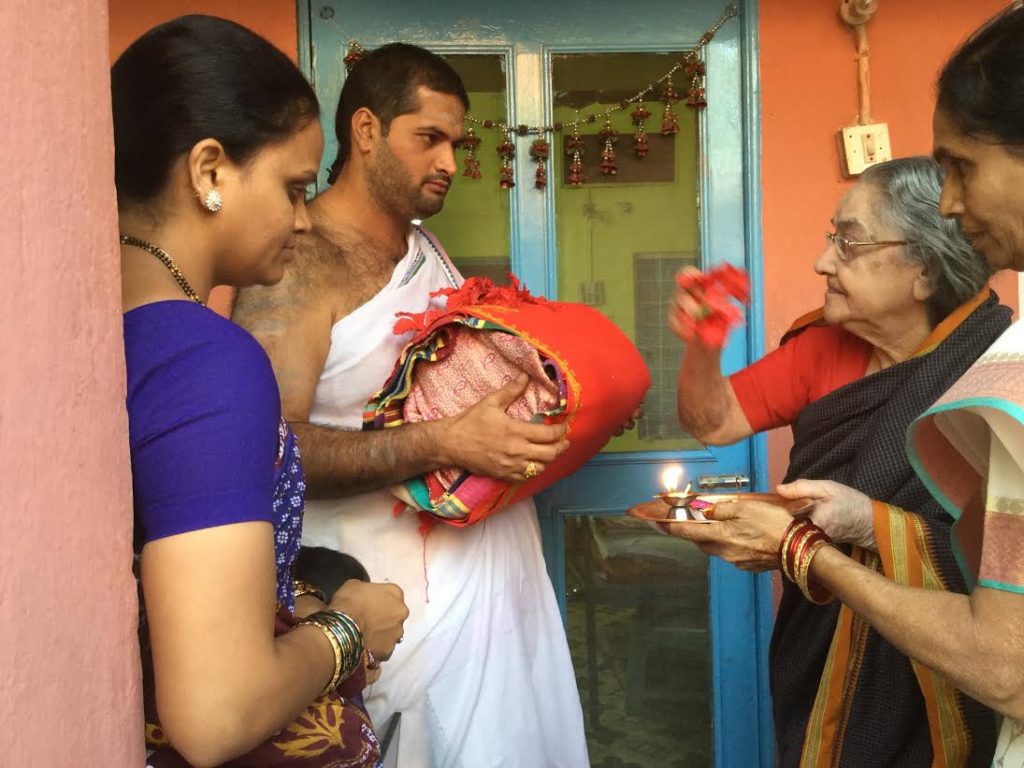 |
|
The Patni (wife of the Yajaman) is vital to the Somayag. The Yajaman must have a wife, and she is called upon at various points in the Somayag to be present for certain activities and often to touch and bless utensils which are used. The Patni is the only person who is given her own quarters in the Somayag shala. The Rutvijas (priests) |
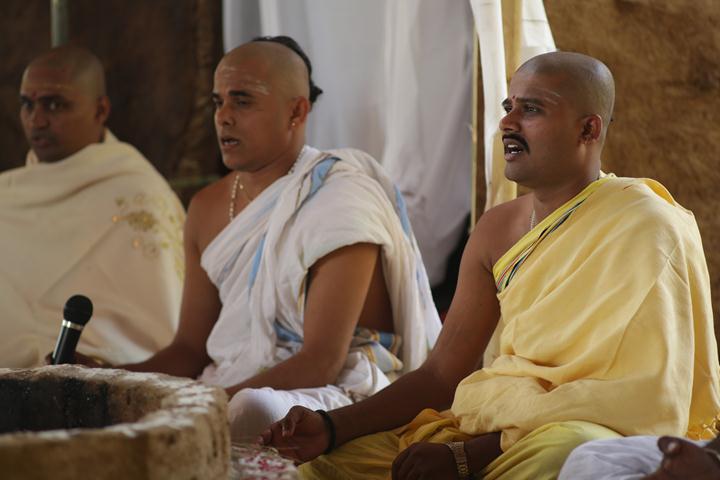 |
|
The sixteen consist of four chief priests and their assistants. |
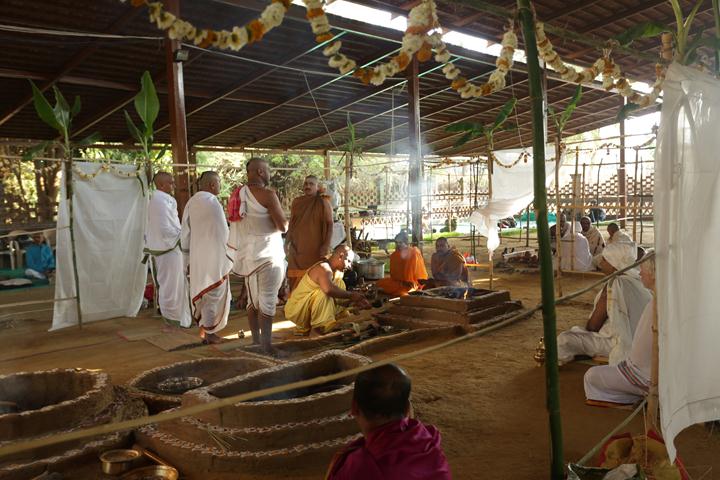 |
|
Creating Pure Fire Energy |
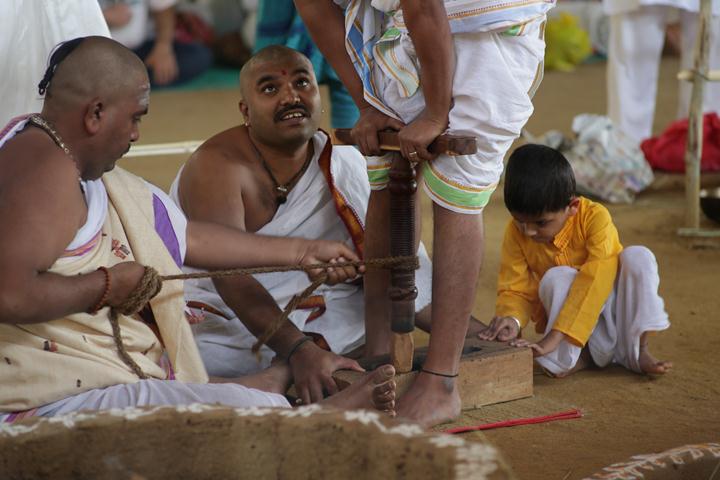 |
|
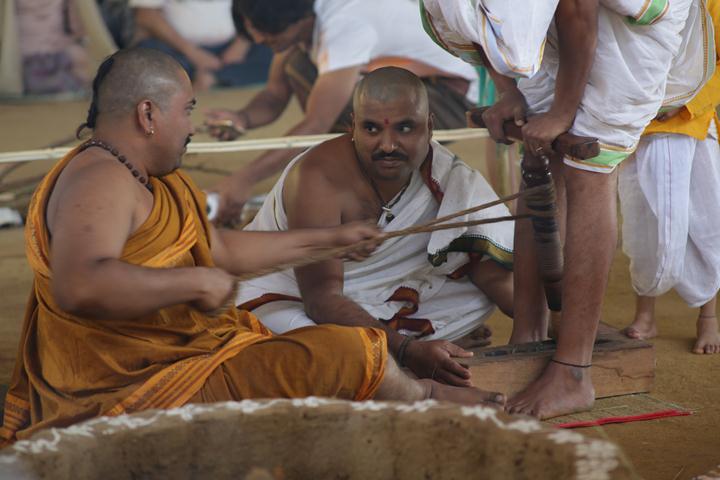 |
|
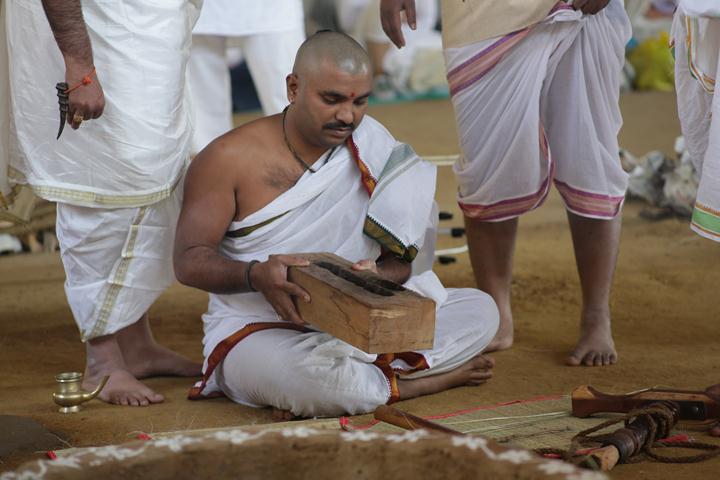 |
|
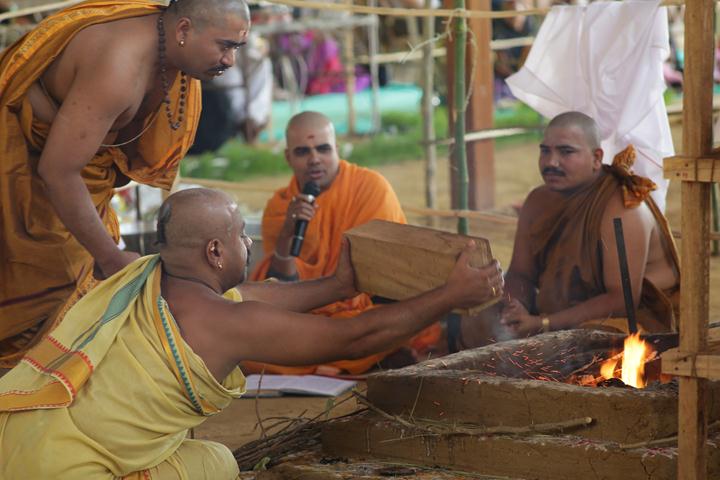 |
|
Pravargya in Somayag |
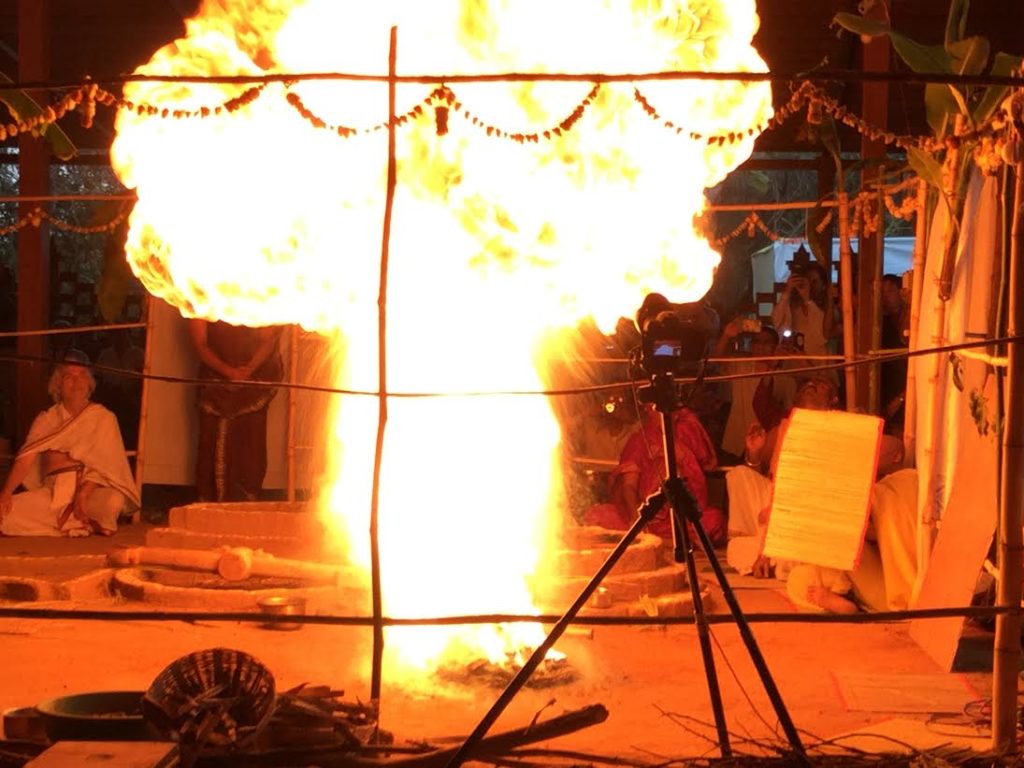 |
Aptoryam Somayag 2017 – Daily Schedule
Somayag is a complex ritual, involving a team of 16 Rutviks (priests). Each has his own responsibilities and will chant from one of the four Vedas. Together, all four Vedas will be represented. A number of different processes and tasks are often going on simultaneously. Following is a brief description together with the approximate timings. (Timings are given in IST – Indian Standard Time – which is 5.5 hours ahead of GMT).
6th February
4pm to 6pm
Fire is first generated in the Tretagni Agnihotra altars (3 altars of the Yajaman). Fire is generated by traditional friction method using two-man block and spindle technique. It is known as Agni Mantan.
7th February
9.30am to 1.00pm
Opening ceremony.
Energetic clearing of the Somayag shala.
Team of priests is gathered.
Fire is transferred from Tretagni altars to the Somayag altars.
5.00pm to 7.30pm
Consecration (Diksha).
8th February7.00am to 1.00pmSomavalli herb is ‘purchased.’ 4.30pm to 7.30pmPravargya. |
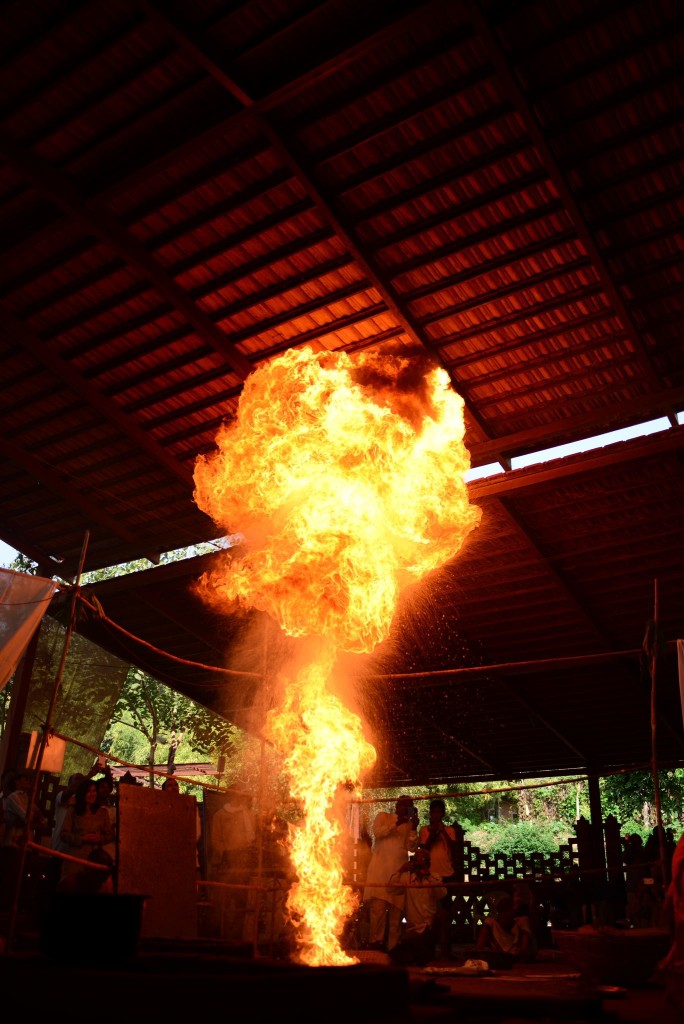 Pravargya |
9th February
9.00am to 12.00pm
Pravargya
Quiet Mantras.
Soma is freshened.
4.30pm to 7.30pm
Pravargya.
Soma is freshened.
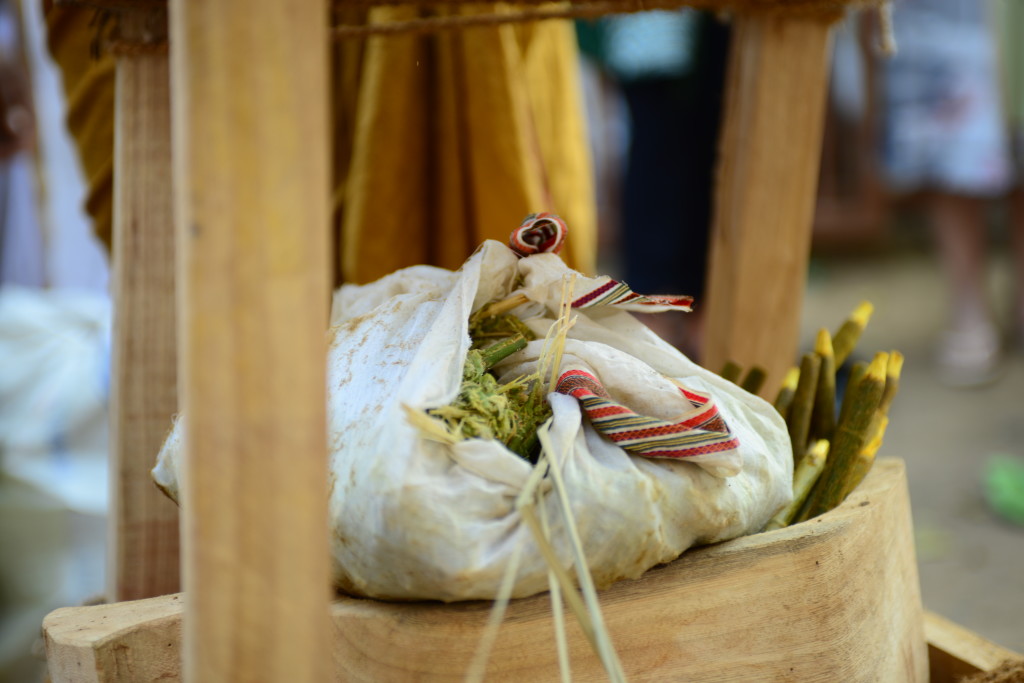
Somavalli
10th February
7.00am to 1.30pm
Pravargyas continue.
5.00pm to 9.00pm
Procession to Mahavedi.
Pravargyas continue.
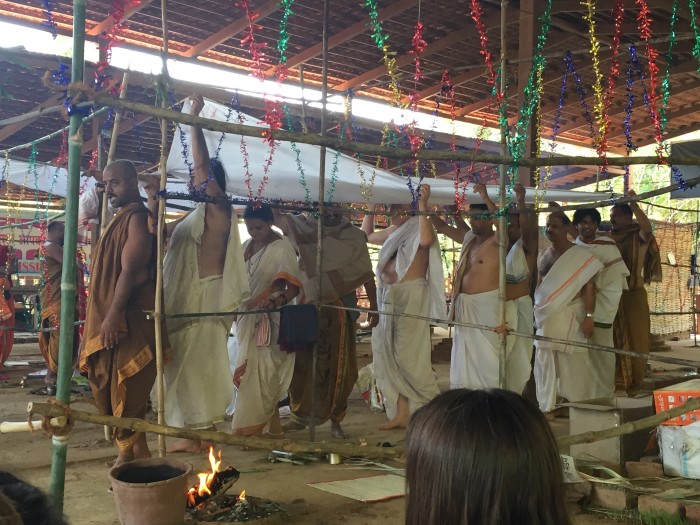
11th February
6.00am to 1.00pm
Offering of Soma into the Uttarvedi.
Everyone has the opportunity to help crush the juice from the Soma.
5.00pm to 1.00am
Offering of Soma into the Uttarvedi.
12th February
4.00am to 7.00am
Rutviks chant, without break, 1,000 Mantras.
9.30am to 12.30pm
Rutviks make offerings to atone for any mistakes they may have made in carrying out their duties in the Somayag.
Final offerings are made.
1.00pm to 2.30pm
Procession down to the river.
Various implements used in the Somayag are thrown into the river.
Everyone takes bath in river.
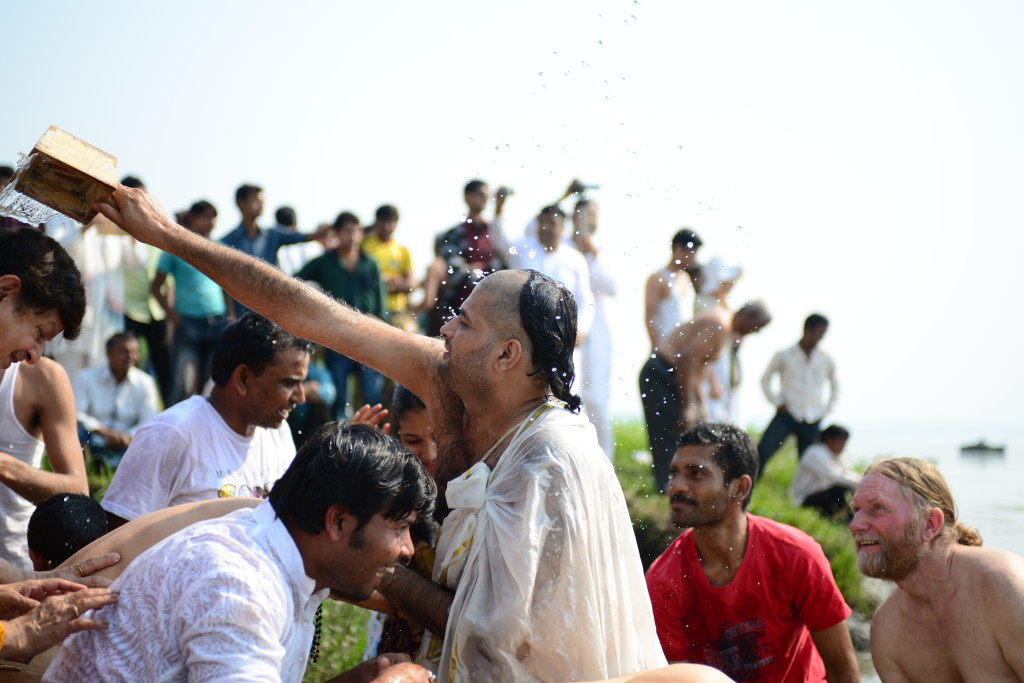
Yajaman douses participants with water from the Narmada.
Aptoryam Somayag 2017 Live Stream
https://www.youtube.com/channel/UC3HhaYZQyB_rfExGvEJ2ZNA
Somayag 2017 Preparation Starts
| Dear Fellow International Agnihotris and Friends of Somayag,
Today in Maheshwar Goshala the Somayag Committee have come together to organize the calender for all preparation work required before the beginning of this most auspicious Somayag, the last of the seven Maha Somayags which were inspired by our beloved Shree Vasant. |
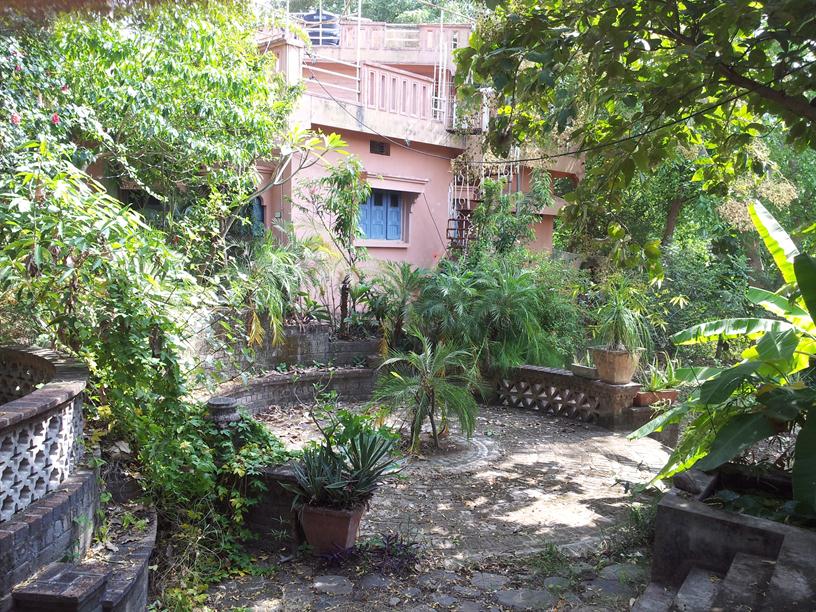 |
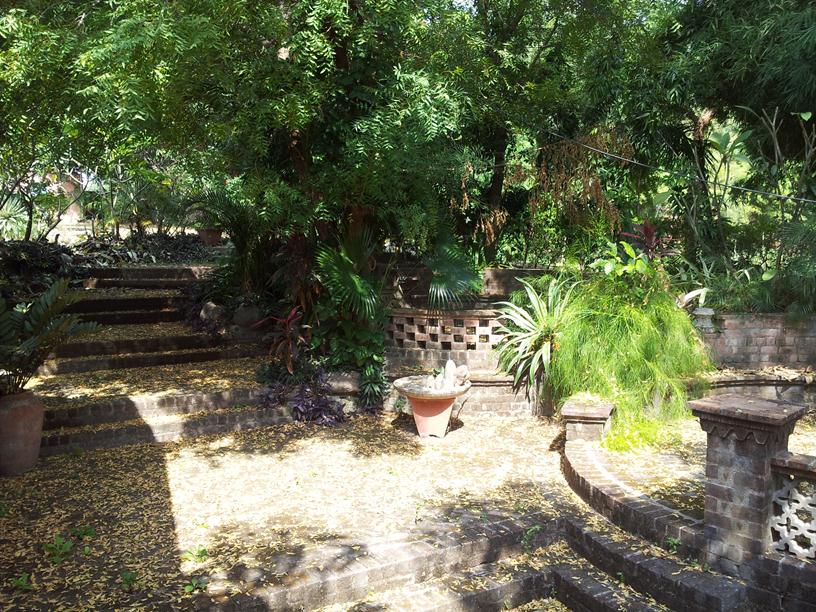 |
Many of you have participated in previous Somayags. For the next three months, we have organized a program of work to be carried out in preparation for this great occasion. |
| Our wish is that despite limitations on the numbers of local and international visitors who can be accommodated here in the Goshala itself, everyone should be able to experience this auspicious and blessed culmination of the preceding six Mahayajynas which have already been completed on this sacred land. | 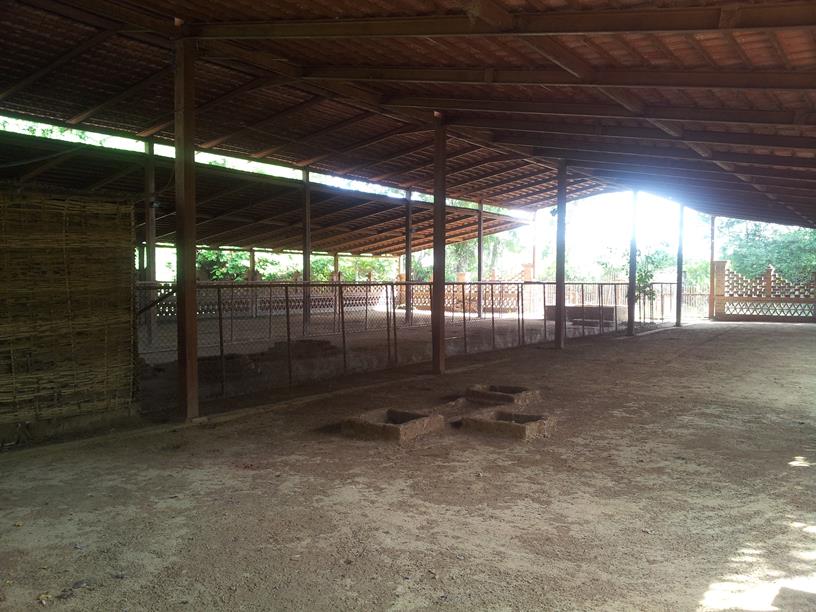 |
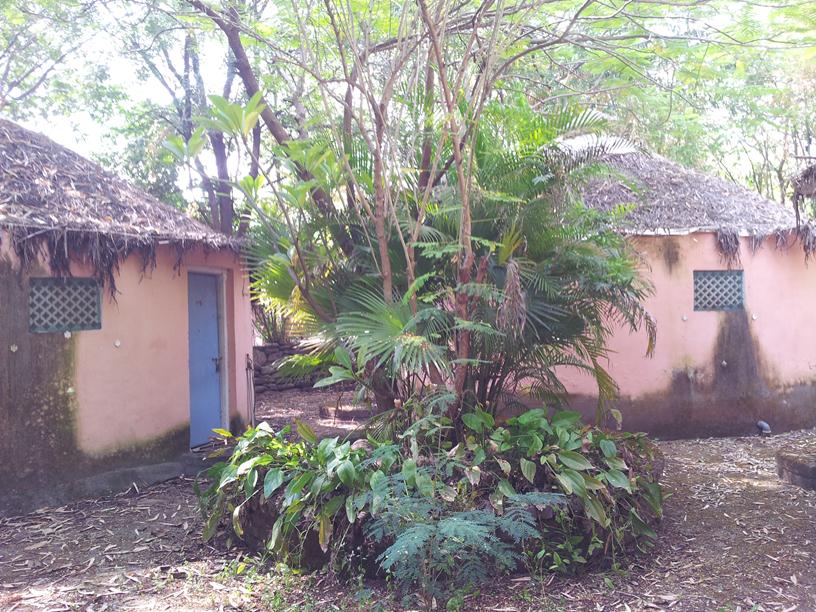 |
We are requesting help in raising the necessary funds to cover the main costs involved both in preparations and also those costs involved in actually organizing and carrying out such an event so all are happy. Costs include repairs, painting, upgrading certain facilities, replanting the organic food garden, and completing all the details which need attention to ensure comfort and ease during your time spent here. |
| Any amount will be helpful and funds are required as soon as possible so the work can begin.
If you can assist please follow the relevant link below. (Monies raised in USA can be sent direct to Fivefold Path, Inc., USA.) |
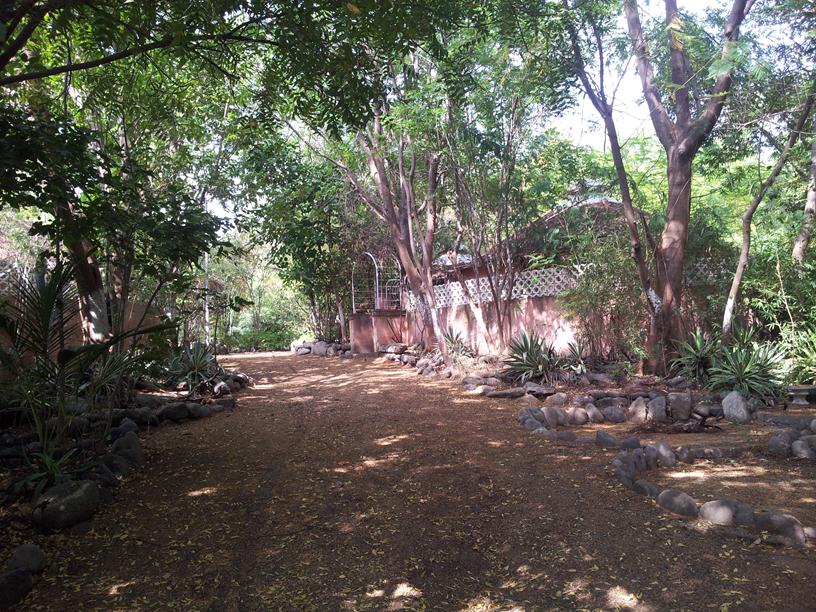 |
Invitation to Somayag 2017
| Dear friends, We are pleased to announce that the last and final Somayag in the series of seven Somayags inspired by Shree Vasant Paranjpe, will be held at the Homa Therapy Goshala, Maheshwar, India February 7-12, 2017. For the past ten years, a small group of people from various countries has kept this vision of conducting a series of seven Maha Somayags on the banks of the River Narmada in Maheshwar, Madhya Pradesh State, for the healing of our planet. |
|
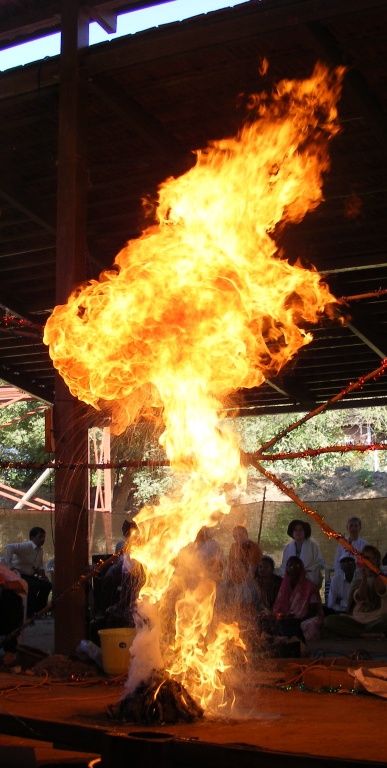 |
To date six of these Somayags have been completed successfully.
The beneficial effects of each of these Somayags last for several decades. The atmosphere becomes medicinal, nutritious and disease free. Somayags yield great benefits to the psyche. They are, of course, part of the Science of Yajnya, of which daily sunrise/sunset Agnihotra is the core practice for the common person. This is an opportunity for all of us to come together again for a cause mightier than all of us together, an opportunity to contribute ourselves to a Higher Goal; no matter how small our individual efforts may be. By coming together in a united effort, we can achieve more than the sum of our parts. Supporting and attending, if possible, such a Somayag helps us realize that it is the journey together which gives us great joy and enhanced meaning to our lives. In those moments together we understand and learn more about life. |
| This 7th Somayag is known as Aptoryam. This Somayag is to help all our families and all living beings in good health as well as to purify our environment and thus help all the planet to regain good health again.
On a more subtle level Aptoryam Somayag is for purification and strengthening our sense organs – and as it is the sense organs through which we perceive the World, if these sense organs are pure and strong, we will be able to achieve Equanimity of Mind and Ultimate Peace. So this particular Somayag will help to unite all humanity. Let us come together and celebrate this time with each other in Unity and Harmony. |
|
Final Somayag Dates Announced 2017
The seventh and final Somayag in the series of seven to be conducted in Homa Therapy Goshala, Maheshwar, has been announced.
Dates will be 7th to 12th February, 2017.
General Information
Travel Information
Accommodation
Hotels in Mumbai and Delhi
Hotels in Maheshwar

